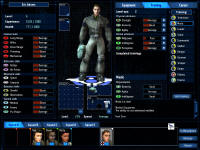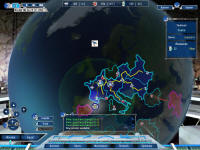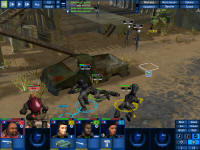It was, quite arguably, the best game of its era: X-Com: UFO Defense. It had everything. A gripping plot. An approachable, iconic art style. Furious, deadly combat. An easily-learned user interface.
It spawned a number of official sequels, and a few imitators, but none of them had the impact of the original. And you can understand why: if you want to play X-Com, you can play X-Com. It’s a game that comes so close to perfection that it’s hard to argue that you even need a sequel.
I could probably write a long article on why X-Com is such a wonderful game. I’m not going to write that today. Today, I’m writing a review of X-Com’s spiritual sequel, UFO: Aftershock. UFO: Aftershock both is and is not a sequel to X-Com. The developers clearly want to tread the line of enjoying the aura of the earlier product, while not actually getting sued for it. Judged as a substitute for X-Com, UFO: Aftershock (inevitably) comes up short. But judged on its own terms, it brings some intriguing things to the table. Let’s take a look at what they are.
X-Com is a turn-based tactical squad combat game where you operate a secret intergovernmental authority that investigates and fights a growing space alien menace. Only one of your squad’s soldiers (or the enemy aliens) can move at one time. Some time ago, I suggested that you could categorize strategy games by the intersection of their control quantum and how movement occurred. In that article, I said “I’d love to see more squad level games where combat is resolved simultaneously.”
Well, UFO: Aftershock is at its heart a squad level game where combat is resolved simultaneously. It is the direct sequel of an earlier game, UFO: Aftermath, that was released several years ago to decidedly mixed reviews. The good news is that Aftershock is more interesting than Aftermath.
Combat is implemented as a curious mixture of X-Com and Baldur’s Gate. On the one hand, you need to direct your squad members explicitly. By default, the game will pause when a squad member has no orders. On the other hand, you can also pause the game at any time and issue new orders for a squad member, adding to or superseding previous orders. Unlike X-Com, all movement and combat is resolved at the same time: you give orders to as many of your men as you like, unpause, and they go forth to conquer or perish.
Among the more successful aspects of UFO: Aftershock is the individuation of squad members. In this style of game, life for squad members is typically nasty, brutish, and short. I might feel some small affection for Kenji Masumoto in X-Com, but realistically I know that every time I send Kenji out on a mission, there’s a damn good chance that he’s going to get cut down in a hail of gunfire the moment he disembarks his aircraft. This means that I try not to get too attached to characters in these games.
In UFO: Aftershock, your squad members are a bit more resilient. They can take more damage, they can heal each other more effectively, and they are modeled with more personality. In X-Com or Jagged Alliance, it’s perfectly common for one lucky shot to blow away a squad member. In UFO: Aftershock, it’s more typical that either everyone in the squad survives, or everyone dies.
Furthermore, as the game progresses they level up, and you decide their career path and specialization. This starts happening almost immediately, at a much faster pace than in similar games, such as Jagged Alliance. So it’s easier to create a vision in your mind of who the character is, and why you don’t want him or her to get killed.
Tactical battles take place in a strategic context. The game uses the “geosphere” graphic introduced in X-Com, but makes the strategic game more sophisticated. The player is confronted with a Risk-like map of territories. Each territory either houses a base (which can be developed to perform research and/or produce items), or provides one of three types of natural resources. Players conquer territories to gain access to these resources, but the act of conquering them also increases the upkeep required to feed your empire. Your base, a movable floating island called a Laputa, can project power over an area about as large as western Europe. Moving the base around takes substantial time, adding another strategic element to the game.
The strategic game shows promise, and is certainly more involved than that in similar games, but feels somehow tacked on. It’s troublesome, because the strategic and tactical games are so different, the overall effect is that each feels like it is interrupting the other. X-Com had this problem too, but combat (at least in the early part of the game) happened much less frequently. This gave you some time to adapt to the strategic game and get some production underway. UFO: Aftershock, on the contrary, rarely allows a single day to pass before forcing you to send your exhausted marines out on another assault. The end result of this is that the strategic game was complex enough to intrigue me, but the game never allowed me to play it enough to feel confident that I was learning its subtleties.
The tactical game is where you will spend most of your time in-game. Viewed purely in terms of game mechanics, it works well. You can apply standard squad assault tactics (two teams leapfrogging, one covering as the other advances, concentrated fire, and so on), and they work just like you’d want them to. There are a good variety of weapons and different skills. Your squad members’ different skills are clearly reflected in combat. Unfortunately, some of the rigging in the tactical game detracts from it. The fact that there are no pre-set turns mean that the game pauses and unpauses wth a frequency that rapidly becomes distracting. The design decision to only have essentially one type of terrain (industrial sites) gives the game an oppressive mood. And anytime you have to go inside a building, or navigate your team under an overpass, you will curse the terrible camera management.
But, of course, a gritty, oppressive mood does not by definition make a squad combat game bad. Many designers strive mightily to impart just such a feel to their games. The problem here is that I — and, let’s face it, everyone else — are comparing the game to its spiritual predecessor, which had a cartoonish, anime style, and a sensibility that came out of the British UFO TV series. Viewed as an attempt to recapture this feel, the game falls short. But viewed as a birds-eye alternative to games such as Rainbow Six, it works quite well. It’s all a matter of perspective.
There are a few bugs that are annoying, though not crippling: ammo sometimes disappears, the geosphere screen will pause for no apparent reason, and teleporters and hot spots that were extremely finicky about where you had to be standing for them to activate. None of the bugs I encountered were crippling,
The bottom line? Hardcore fans of tactical squad combat games may very well want to try UFO: Aftershock for its unusual real-time combat resolution. Players looking for the second coming of X-Com are probably better served by a Gameboy Advance and a copy of Rebestar: Tactical Command.
Additional Notes
- Disclosure: The publisher provided me with a review copy of the game.
- UFO: Aftershock uses StarForce copy protection, but it can be avoided fairly easily.
- The UFO: Aftershock homepage contains information about the game, as well as about its upcoming sequel.








I’m in the minority, but I always liked the Jagged Alliance series more than X-Com — mostly because of the voices and personalities of the characters, and how that let me get attached to them. That and the little footpaths that showed movement cost before actually moving made it harder to go back to X-Com.
What I really want is a game with the interface and characters of Jagged Alliance with all the cool toys and aliens of X-Com. And I’m trying so hard not to reinstall either game right now…
The biggest problem I had playing this game enough to review it was that I kept playing X-Com to compare, and then I’d look at the clock and I’d been playing X-Com for 4 hours.
What made it worse was that I found a strange little Japanese program that lets you play any directX game in a standard Windows window. So I could have X-Com in the background while working on other stuff. Oh, addiction.
Did you really mean Laser Squad Nemesis?
If there is a version of LSN for the GBA, I’d really love to find it, but I can’t. Did you mean some other game?
Ah XCom, one of my favorite games of all time. I remember my favorite unkillable squaddies well – they’d go on mission after mission, somehow staying alive. I miss those guys.
I believe the Gameboy game is “Rebelstar: Tactical Commando. It looks very cute.
Paul is correct; I was confused because they were made by the same developer. I’ll correct the article.
I have Rebelstar. It’s a ton of fun and I love it very very much.
I never played the first X-Com, but X-Com terror from the deep took hundreds of my hours from me. Is it actually possible to get ahold of those old games for less than say $5?
-Doug
Holy-Moly! X-com UFO defense costs $46 on half.com
It is annoying when you have bought a game more than once and to replace it again would cost more than the first two times combined.
Gosh, that’s terrible. Hmm…what to do, what to do…
http://209.120.136.195/
I recently dusted off X-Com and started playing it again. What a great game.
Peterb – where did you get that “program that lets you play any directX game in a standard Windows window”?
Then I could be playing XCom a lot more!
-Don
I recently dusted off X-Com and started playing it again. What a great game.
Peterb – where did you get that “program that lets you play any directX game in a standard Windows window”?
Then I could be playing XCom a lot more!
-Don
Don,
You want a program called “D3DWindower”.
You can get it here: http://www.geocities.jp/menopem/
Regrettably, the site is all in Japanese, but just click the link near the top labeled “DirectX” to download.
To make it work:
1. Create a X-Com shotcut on the desktop.
2. Run D3Dwindower.
3. Click the “+” button, locate the xcom shotcut.
4. Click the “Play” button.
5. Double click the X-Com shotcut.
There are various options in the program you can play with. I’ll fire mine up tonight to see what settings I have on it.
I would pay any amount of money for x-com on the nintendo DS. It’s so perfectly suited to the touch screen, in addition to being one of my favorite games of all time.
As the PR agent for UFO: Aftershock I won’t comment on the game, I’d be too biased Instead, I will comment on X-Com
Instead, I will comment on X-Com
I guess I’m in the minority when I say I can’t go back and play X-com. I’m not sure of the reason, it isn’t the graphics… I loved that game years ago and now… it just doesn’t “do it” for me anymore.
Strange but true. Thanks for the review Peter!
Thanks for the tip on “Rebelstar: Tactical Commando.” I ordered a copy (used) for my GBA, and it arrived today. After playing for 90 minutes, I’m hooked. Fun.
Cheers,
Tom